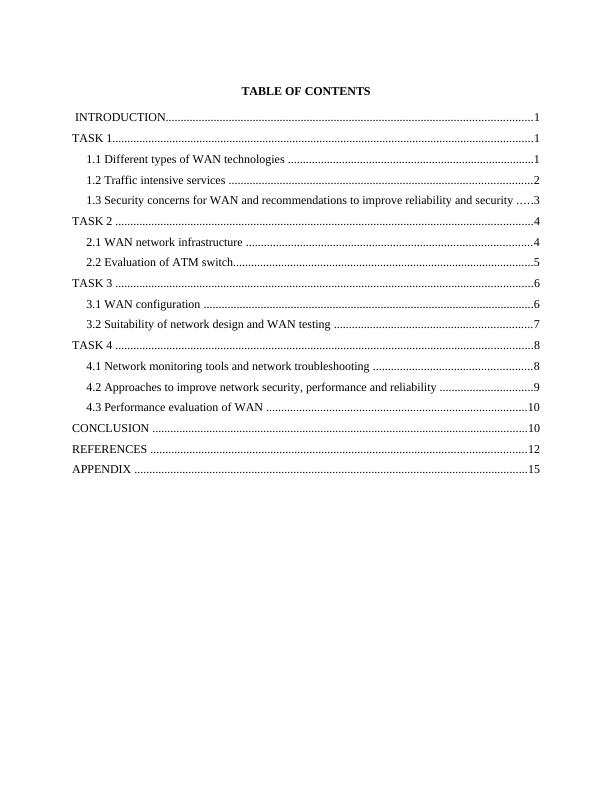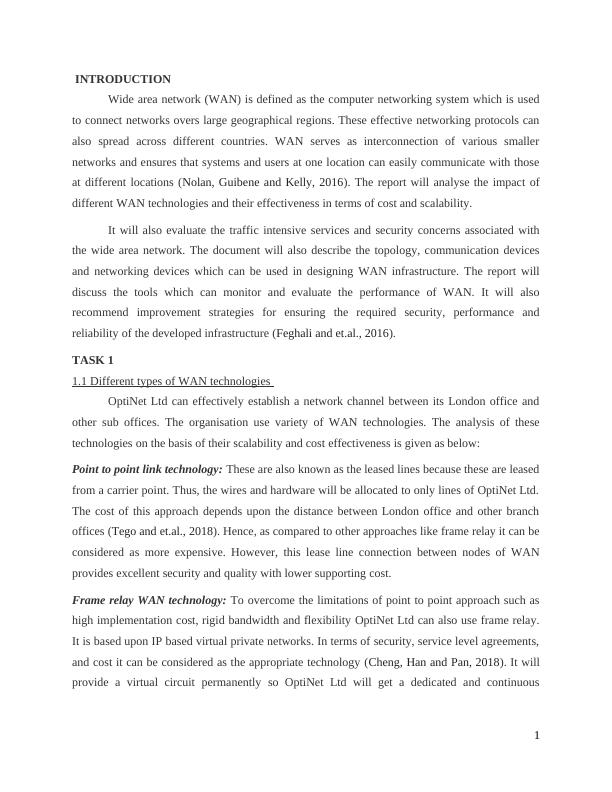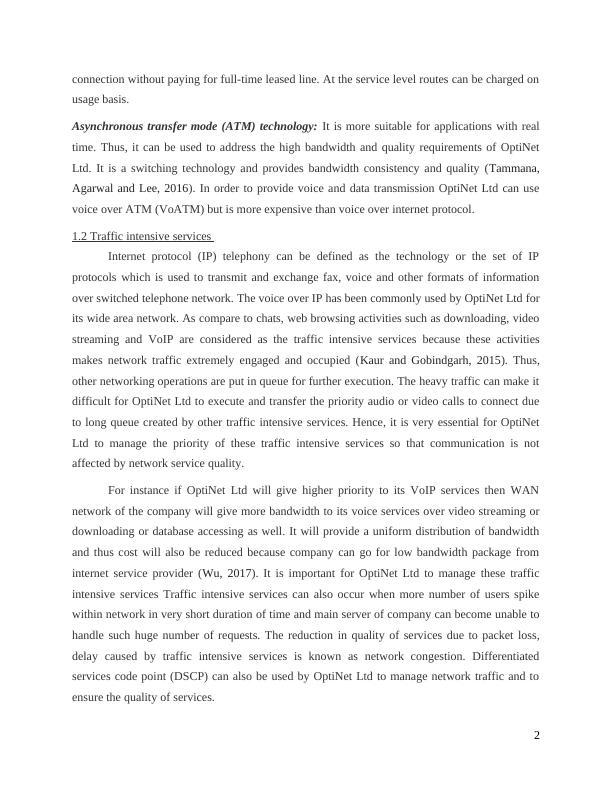Towards Wide Area Networking Technologies
18 Pages5262 Words451 Views
Added on 2020-12-30
About This Document
Wide Area Networking Technologies TABLE OF CONTENTS INTRODUCTION 1 TASK 11 1.1 Different types of WAN technologies1 1.2 Traffic intensive services 2 1.3 Security concerns for WAN and recommendations to improve reliability and security 3 TASK 24 2.1 WAN network infrastructure 4 2.2 Evaluation of ATM switch 5 TASK 36 3.1 WAN configuration 6 3.2 Suitability of network design and WAN testing 7 TASK 48 4.1 Network monitoring tools and network troubleshooting8 4.2 Approaches to improve network security, performance and reliability9 4.3 Performance evaluation of WAN 10
Towards Wide Area Networking Technologies
Added on 2020-12-30
ShareRelated Documents
Wide Area Networking
Technologies
Technologies

TABLE OF CONTENTS
INTRODUCTION..........................................................................................................................1
TASK 1............................................................................................................................................1
1.1 Different types of WAN technologies ..................................................................................1
1.2 Traffic intensive services .....................................................................................................2
1.3 Security concerns for WAN and recommendations to improve reliability and security .....3
TASK 2 ...........................................................................................................................................4
2.1 WAN network infrastructure ...............................................................................................4
2.2 Evaluation of ATM switch....................................................................................................5
TASK 3 ...........................................................................................................................................6
3.1 WAN configuration ..............................................................................................................6
3.2 Suitability of network design and WAN testing ..................................................................7
TASK 4 ...........................................................................................................................................8
4.1 Network monitoring tools and network troubleshooting .....................................................8
4.2 Approaches to improve network security, performance and reliability ...............................9
4.3 Performance evaluation of WAN .......................................................................................10
CONCLUSION .............................................................................................................................10
REFERENCES .............................................................................................................................12
APPENDIX ...................................................................................................................................15
INTRODUCTION..........................................................................................................................1
TASK 1............................................................................................................................................1
1.1 Different types of WAN technologies ..................................................................................1
1.2 Traffic intensive services .....................................................................................................2
1.3 Security concerns for WAN and recommendations to improve reliability and security .....3
TASK 2 ...........................................................................................................................................4
2.1 WAN network infrastructure ...............................................................................................4
2.2 Evaluation of ATM switch....................................................................................................5
TASK 3 ...........................................................................................................................................6
3.1 WAN configuration ..............................................................................................................6
3.2 Suitability of network design and WAN testing ..................................................................7
TASK 4 ...........................................................................................................................................8
4.1 Network monitoring tools and network troubleshooting .....................................................8
4.2 Approaches to improve network security, performance and reliability ...............................9
4.3 Performance evaluation of WAN .......................................................................................10
CONCLUSION .............................................................................................................................10
REFERENCES .............................................................................................................................12
APPENDIX ...................................................................................................................................15

INTRODUCTION
Wide area network (WAN) is defined as the computer networking system which is used
to connect networks overs large geographical regions. These effective networking protocols can
also spread across different countries. WAN serves as interconnection of various smaller
networks and ensures that systems and users at one location can easily communicate with those
at different locations (Nolan, Guibene and Kelly, 2016). The report will analyse the impact of
different WAN technologies and their effectiveness in terms of cost and scalability.
It will also evaluate the traffic intensive services and security concerns associated with
the wide area network. The document will also describe the topology, communication devices
and networking devices which can be used in designing WAN infrastructure. The report will
discuss the tools which can monitor and evaluate the performance of WAN. It will also
recommend improvement strategies for ensuring the required security, performance and
reliability of the developed infrastructure (Feghali and et.al., 2016).
TASK 1
1.1 Different types of WAN technologies
OptiNet Ltd can effectively establish a network channel between its London office and
other sub offices. The organisation use variety of WAN technologies. The analysis of these
technologies on the basis of their scalability and cost effectiveness is given as below:
Point to point link technology: These are also known as the leased lines because these are leased
from a carrier point. Thus, the wires and hardware will be allocated to only lines of OptiNet Ltd.
The cost of this approach depends upon the distance between London office and other branch
offices (Tego and et.al., 2018). Hence, as compared to other approaches like frame relay it can be
considered as more expensive. However, this lease line connection between nodes of WAN
provides excellent security and quality with lower supporting cost.
Frame relay WAN technology: To overcome the limitations of point to point approach such as
high implementation cost, rigid bandwidth and flexibility OptiNet Ltd can also use frame relay.
It is based upon IP based virtual private networks. In terms of security, service level agreements,
and cost it can be considered as the appropriate technology (Cheng, Han and Pan, 2018). It will
provide a virtual circuit permanently so OptiNet Ltd will get a dedicated and continuous
1
Wide area network (WAN) is defined as the computer networking system which is used
to connect networks overs large geographical regions. These effective networking protocols can
also spread across different countries. WAN serves as interconnection of various smaller
networks and ensures that systems and users at one location can easily communicate with those
at different locations (Nolan, Guibene and Kelly, 2016). The report will analyse the impact of
different WAN technologies and their effectiveness in terms of cost and scalability.
It will also evaluate the traffic intensive services and security concerns associated with
the wide area network. The document will also describe the topology, communication devices
and networking devices which can be used in designing WAN infrastructure. The report will
discuss the tools which can monitor and evaluate the performance of WAN. It will also
recommend improvement strategies for ensuring the required security, performance and
reliability of the developed infrastructure (Feghali and et.al., 2016).
TASK 1
1.1 Different types of WAN technologies
OptiNet Ltd can effectively establish a network channel between its London office and
other sub offices. The organisation use variety of WAN technologies. The analysis of these
technologies on the basis of their scalability and cost effectiveness is given as below:
Point to point link technology: These are also known as the leased lines because these are leased
from a carrier point. Thus, the wires and hardware will be allocated to only lines of OptiNet Ltd.
The cost of this approach depends upon the distance between London office and other branch
offices (Tego and et.al., 2018). Hence, as compared to other approaches like frame relay it can be
considered as more expensive. However, this lease line connection between nodes of WAN
provides excellent security and quality with lower supporting cost.
Frame relay WAN technology: To overcome the limitations of point to point approach such as
high implementation cost, rigid bandwidth and flexibility OptiNet Ltd can also use frame relay.
It is based upon IP based virtual private networks. In terms of security, service level agreements,
and cost it can be considered as the appropriate technology (Cheng, Han and Pan, 2018). It will
provide a virtual circuit permanently so OptiNet Ltd will get a dedicated and continuous
1

connection without paying for full-time leased line. At the service level routes can be charged on
usage basis.
Asynchronous transfer mode (ATM) technology: It is more suitable for applications with real
time. Thus, it can be used to address the high bandwidth and quality requirements of OptiNet
Ltd. It is a switching technology and provides bandwidth consistency and quality (Tammana,
Agarwal and Lee, 2016). In order to provide voice and data transmission OptiNet Ltd can use
voice over ATM (VoATM) but is more expensive than voice over internet protocol.
1.2 Traffic intensive services
Internet protocol (IP) telephony can be defined as the technology or the set of IP
protocols which is used to transmit and exchange fax, voice and other formats of information
over switched telephone network. The voice over IP has been commonly used by OptiNet Ltd for
its wide area network. As compare to chats, web browsing activities such as downloading, video
streaming and VoIP are considered as the traffic intensive services because these activities
makes network traffic extremely engaged and occupied (Kaur and Gobindgarh, 2015). Thus,
other networking operations are put in queue for further execution. The heavy traffic can make it
difficult for OptiNet Ltd to execute and transfer the priority audio or video calls to connect due
to long queue created by other traffic intensive services. Hence, it is very essential for OptiNet
Ltd to manage the priority of these traffic intensive services so that communication is not
affected by network service quality.
For instance if OptiNet Ltd will give higher priority to its VoIP services then WAN
network of the company will give more bandwidth to its voice services over video streaming or
downloading or database accessing as well. It will provide a uniform distribution of bandwidth
and thus cost will also be reduced because company can go for low bandwidth package from
internet service provider (Wu, 2017). It is important for OptiNet Ltd to manage these traffic
intensive services Traffic intensive services can also occur when more number of users spike
within network in very short duration of time and main server of company can become unable to
handle such huge number of requests. The reduction in quality of services due to packet loss,
delay caused by traffic intensive services is known as network congestion. Differentiated
services code point (DSCP) can also be used by OptiNet Ltd to manage network traffic and to
ensure the quality of services.
2
usage basis.
Asynchronous transfer mode (ATM) technology: It is more suitable for applications with real
time. Thus, it can be used to address the high bandwidth and quality requirements of OptiNet
Ltd. It is a switching technology and provides bandwidth consistency and quality (Tammana,
Agarwal and Lee, 2016). In order to provide voice and data transmission OptiNet Ltd can use
voice over ATM (VoATM) but is more expensive than voice over internet protocol.
1.2 Traffic intensive services
Internet protocol (IP) telephony can be defined as the technology or the set of IP
protocols which is used to transmit and exchange fax, voice and other formats of information
over switched telephone network. The voice over IP has been commonly used by OptiNet Ltd for
its wide area network. As compare to chats, web browsing activities such as downloading, video
streaming and VoIP are considered as the traffic intensive services because these activities
makes network traffic extremely engaged and occupied (Kaur and Gobindgarh, 2015). Thus,
other networking operations are put in queue for further execution. The heavy traffic can make it
difficult for OptiNet Ltd to execute and transfer the priority audio or video calls to connect due
to long queue created by other traffic intensive services. Hence, it is very essential for OptiNet
Ltd to manage the priority of these traffic intensive services so that communication is not
affected by network service quality.
For instance if OptiNet Ltd will give higher priority to its VoIP services then WAN
network of the company will give more bandwidth to its voice services over video streaming or
downloading or database accessing as well. It will provide a uniform distribution of bandwidth
and thus cost will also be reduced because company can go for low bandwidth package from
internet service provider (Wu, 2017). It is important for OptiNet Ltd to manage these traffic
intensive services Traffic intensive services can also occur when more number of users spike
within network in very short duration of time and main server of company can become unable to
handle such huge number of requests. The reduction in quality of services due to packet loss,
delay caused by traffic intensive services is known as network congestion. Differentiated
services code point (DSCP) can also be used by OptiNet Ltd to manage network traffic and to
ensure the quality of services.
2

End of preview
Want to access all the pages? Upload your documents or become a member.
Related Documents
The Use and Importance of Network Monitoring Toolslg...
|25
|5245
|53
Networking Fundamentals : Assignmentlg...
|3
|1964
|98
BHIS 515: Biomedical and Health Information Scienceslg...
|10
|2029
|40
Network Design Assignment (Doc)lg...
|20
|5604
|583
MPLS VPN and CISCO 2811 3 Implementation of PE Routerslg...
|9
|2165
|317
Riordan Network Security Recommendations Assignmentlg...
|5
|923
|161
